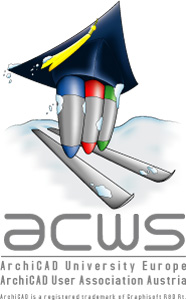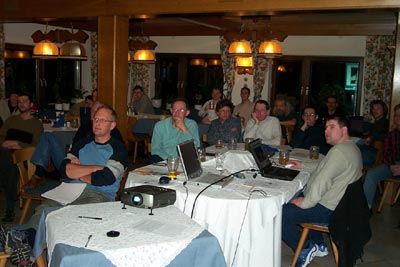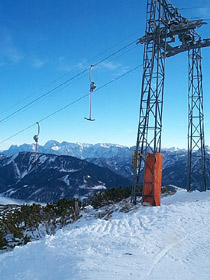ArchiCAD Winter School 2004 : 17-24 January 2004 : It happened!


See the Report from ArchiCAD
Winter School_2003
Sunday
18 th Jan
We are on top of a mountain in perfect
skiing conditions - over a metre of snow cover, and light fresh falls
at nighttime. The first day, Sunday, provided ideal skiing conditions
in the morning with sunshine and wonderful distant views. Some cloud moving
in the afternoon reduced visibility on the higher slopes later in the
day. Even when you can't "see" what you are skiing on, the surface
is so good that you can turn and manoevre confidently.
There are 38 of us up here and the hotel is full. People from Britain, Norway, Denmark, Poland, Slovakia, Germany and of course Austria.
The first evening was a catchup session on the secrets of ArchiCAD 8.1 (some dialog boxes I didnt know about) with Simon Gilbert, the UK technical support with GS. Then we had László Néda from Budapest who is "Mister Wishlist" at Castle Graphisoft, and we had a most interesting discussion till after 11pm on things that we wished for ArchiCAD and Plotmaker - some far thinking ideas with such an intense audience.
Monday
19
Skiing
conditions for Monday were unbelievable! Perfect visibility all day,
sunshine on south facing slopes till after 4pm, no ice on the pistes (fresh
snow coating at the weekend), all lifts operating. Snow is expected overnight
and Tuesday, so we enjoy it while we can.
The evening talks were also excellent. The topic was 'Rendering and presentation'. The enchanting Ildiko Szabo of Abvent gave a presentation on three topics.
- www.ArchiGate.net
is a new web server for architects to deposit project information and
set up access levels for clients, colleagues etc. ArchiGate is well
established in France, and due to be available in German and English
this spring.
- The second item was the relaunched AV-Works 2 for ArchiCAD 8.1, greatly improved from version 1. This has been made possible by replicating ArchiCAD's library of lamps with additional parameters such as soft shadows, global illumination etc.
- This was pretty good, but we were then knocked off our seats by her third topic which was a new product called PhotoCAD. We thought "oh not another stitcher", but within 10 mins, we were all asked if she takes credit card right now! This stitches Cylindrical and Spherical panoramas, but in a most sexy way - as you bring the pictures in to join them they are preshaped so you see the cylinder forming - and you pan and zoom effortlessly as you join the pictures. Uneven light levels or distortion from wide angle lenses are capable of being corrected; people who have moved between photographs can be selectively hidden, hotspots for jumping to the next panorama can be drawn, and by distortion extraction, elevations of buildings can be extracted as accurate flat images - and then mapped onto ArchiCAD or Sketchup wall surfaces. Compilation of the final panorama takes seconds instead of minutes as with Apple's VR authoring tool.
The next presentation was by Pavol Elias from Dunako in Slovakia with a world beating product ArchiShock3D, which is a 3D export to Shockwave 3D, and a template for using in a website which means that a comprehensive building model can be viewed and walked around in a normal web browser. Works on Mac and PC. This is a wonderful innovation, and effectively replaces GS's very flaky GDL browser and VR Objects and VR walkabouts and flythroughs at a stroke. File sizes are smaller than traditional VR or movies, the model streams on to your page visually as it downloads (so you see it building), the Open GL rendering is more sophisticated than ArchiCAD's (good glass!). It also works in ArchiCADs publisher, so that a rotatable/ walkaboutable 3d model is now included with the other drawings. All the client needs is Open GL on their PC/Mac, and download the free Shockwave plugin. Pavol will be at ArchiCAD University in Nottingham, and either Pavol or David NC will show this incredible plugin at ACUWest in Pomona in March.
The final presentation was from Simon Gilbert of Graphisoft, of ArchiLumos, which appears every bit as good as the rumours say. They, like Abvent have also taken the ArchiCAD lights library and added more code so that light output is measured in Lumens, or can follow downloadable IES data from lighting manufacturers. The Plug in makes its own model of the surfaces in the environment of your view, assembles the surfaces and lights in a floating window/pallete, and you can then generate the final view.
Views of the Heumatsgupf from the terrace
of Berggasthof Edelweiss, Feuerkogel.
Skiing from Andor Szolke (Hungary), Charlotte Darre (Denmark), Ildiko
Szabo (Hungary), David Nicholson-Cole (UK).
|
Tuesday 20 Monday night changed from sunny all day
to driving wind late in the evening and we were frequently wakened
during the night by the heavy gusts, and in the Tuesday morning,
we all enjoyed a morning in the comfort of the Edelweiss Hotel,
watching a few brave souls braving the Force 7 wind outside. The evening was in 2 channels, some
15/16 people braving an evening of Advanced GDL from David
Nicholson-Cole, with a demonstration of many objects that
exemplified advanced techniques. (Report on the ArchiCAD workshop by Mike Waddingham and ArchiBen Frost) Music maestro! Everyone was so keyed up that we continued in the Kellerbar, but this time, strictly with the emphasis on enjoying the beer and Herbert Peter (and DNC) playing the guitar and a few brave ones singing (for some) until 2, 3, 4, 5, and for a few crazies, 6am!! Wednesday 21 Although snow was still falling, visibility was good and the skiing was excellent for those who wanted to learn powder skiing. the Austrians are just magic as ski teachers and have great patience with anybody who wants to learn. The official ski school have a brilliant teacher called Franz, who has brought on the beginners to confident intermediates. In the evening, people continued with the workshops from the night before, the ArchiCAD people taking that further (there will be another report on that soon), and the GDL people discussing Graphical hotspots before embarking on making some GDL models of skilift and cable cars structures as an example of hotspots and many other advanced techniques. |
Thursday 22
Fresh
snowfall over night and the whole resort was coated with delightful powder
that made for some of the safest and most interesting skiing that anybody
could ask for. As specks were still falling (and people enjoying it) the
piste machine only flattened the beginners slopes, so we enjoyed the more
advanced slopes with nearly half a metre of fresh powder cover to explore.
This is the most 'cake-icing' I have ever seen, yet it feels like an infinitely
soft feather quilt. Some of the Austrian Archicad users took us out and
taught us soft powder techniques till we were totally confident.
After a morning of this, the lovely icing was full of interesting patterns
of ski tracks, and sometimes of large bum marks; yet no injuries, only
laughs.
We were taught so well that on the following day when the pistes were
machined down, we relative beginners were still seeking out soft side
areas to do some of our turns.
Demo of powder sport by Chris Johnson (Scotland), Jorn Lovland (Norway), Laszlo Neda (Hungary), Herbert Graier (Austria).
|
The
Igloo Pub: The locals had created an IGLOO pub during
the week, so we enjoyed an hour of night skiing 8-9 by floodlights.
They had piled up a massive mound of snow during the previous weeks
which had compacted nicely. During our week, they were carving it
out with a chainsaw and by Thursday evening it was a welcoming Pub
with electric lighting and a bar, and people could ski into it,
take a cup of punch and ski out again. Evening session: About 10.00, Mike Lucey (from western Ireland) gave a long talk on Sketchup, intuitive 3D modelling software. His practice has made extensive use of this, and for construction, he is migrating from AutoCAD to ArchiCAD. He also showed us the Sketchup equivalent of ArchiCAD talk, a very active forum, with a huge resource of examples of users work and downloadable objects and files. Maybe this was the alcohol acting, but the best skiers in the group decided on a midnight ski, climbed the Heumahdgupf peak nearby and skied down through the soft stuff lit only by starlight and the light from Jorn Lovland's miners lamp helmet. |
 |
Friday 23
The skiing conditions and sunshine were 110%, the kind of day that Alex (our hotel owner) said we may only get once or twice in a winter. The pistes were smoothed now, and with the mesh of runs and lifts, we could enjoy great variety. There were ski races taking place on the long chair lift run, and we shared the mountain and valley with a lot of enthusiastic day skiers and spectators. László Néda of Graphisoft took a detour to the hospital in Gmunden to have his head repaired after falling at speed and hitting his own ski - but he never stops smiling!
In the evening, we had our usual 'POT LUCK' of presentations, but as the hotel design team were still frantically polishing off the design, we left the start till 9pm.
- DavidNC from Nottingham kicked off with some travel info for the flying delegates and a presentation of some Cadburys chocolate to the two waitresses, Nicole and Daniella.
- Pavol Elias from Slovakia showed some work a a few years back in which he was developing algorithms for interpreting the false perspectives of one of the impossible objects in a drawing by Escher - the Belvedere - the boy in the bottom left corner is puzzling over just such an object.
- David NC showed one of his current GDL projects, a GDL configurator for Velfac 200 range windows (an unfunded research project) that can produce all of the current configurations (about 60) plus another million or two. (A GDL configurator for Norwegian windows had been shown to both groups back on Tuesday.)
- David also showed the delegates ArchiCAD-Talk, quickly explaining how the system worked, and showing an example of BBCode. He also showed some extracts from the ArchiPUB and GDL Talk.
- Charlotte Darre a 22yr old student from Aarhus, Denmark, showed the work of her GDL class in Aarhus (which has had some late-in-the-day teaching input from David NC). The students have been tackling serious building technology tasks, and were required to build a small building at the end using the GDL objects, such as stairs, doors, windows, ceilings, flooring, bathrooms. Her task was precast walling panels (conforming to manufacturers rules), with a well developed user interface and graphical hotspots.
- Adrian Harms from Nottingham took us through a quick demonstration of Piranesi - retouching software with remarkable options for finally texturing the image, inserting people and vegetation and for applying artistic effects.
- Georg Weber from Munchen Gladbach, showed us the work he has been doing in retail, with recent work setting up shops within shops for Alberto, a manufacturer of fashion trousers; something like 3 shops a week. These are done in hours thanks to the investment made in GDL objects which when brought together complete the shop and all listing information required. He has also done some houses which we saw some of last year.
- Gerhard Hladik from Salzburg, showed us a cute trick with Mesh Objects. He has written a neat little GDL file during the week which takes a mesh object, and generates a version of it cut into slices at user settable heights to show the contours of it in 2D and 3D.
- Simon Gilbert, of Graphisoft UK, showed us a quick view of ArchiGUIDE and then showed an interesting construction simulation project for drilling railway tunnels. He finished with a quick canter through some of the movies of skiers at the Winter School, including some spectacular powder skiing from László Néda and Herbert Graier, stylish graceful action from Ildiko Szabo and Herbert Peter, and some exposition of the school of straight-legs-apart skiing from DNC.
- Andreas Lettner and Herbert Peter (from Innsbruck and Vienna) presented a design scheme they had developed in about 15 hours with ArchiCAD/Teamwork for a new Feuerkokel Hotel to replace the ruined Berghof next to the Cablecar station. This was a strikingly modernist response to the site, and would represent an impressive object on the skyline for arrivals in the new cablecar. This project has been an inspiration to a theme for the Winter School of 2005.
- Adrian Harms had used a contour plan of the Feuerkogel locality to generate a 3D model of the site (roughly with 100m contours) and planted over 1000 ArchicAD trees, and the hotel design. He used Navisworks thereafter to show us how fast it is in coping with many polygons.
- David NC
closed with a quick show of Ecotect software, the building environmental
prediction software from Andrew Marsh of Cardiff University (http:/www.ecotect.com/)
Saturday
24
The skiing conditions were so perfect, we decided to stay on till lunchtime and we were awarded free extensions to our ski hire and lift passes for the half day. For those who travelled to Salzburg it was highly rewarding. We found time to have a quick look round both Mozart's Living house and Birth house. That day, there was a big international outdoor music festival, using highly coloured facepainted, coloured costumed groups of about 20 each, brass, drums and dancing. Although we were too late to see the main parade, the bands were walking around the city, entertaining in every street and platz of the pedestrianised city centre.
ACUE Winter School
There is a most remarkable chemistry in the whole event - the magic combination of altitude, fresh air, feeling the improving fitness and skills is unequalled any other way - and then there is the most remarkable networking and friendship making in the evenings.
And having had the best snow conditions in recent memory (more than five years have gone by since anybody there can remember such a good winter) there were no grumbles about the skiing conditions, even though we took a rest during Tuesday. Although Feuerkogel is no Kitzbuhl, it has just the right combination of skiing environment to keep the experts and beginners happy alike. There is an excellent ski school at Feuerkogel, and every ACU Winter School introduces a new generation of newcomers to skiing. Its cheap and friendly, the family run Hotel treat us marvellously and provide excellent food and drink.
The program was more relaxed to allow people time to use their laptops for private work. Being able to keep in touch with home and office via broadband is helpful, and laptops enabled people to do a bit of work in spare time.
ACUEWinter School is organised by ArchiCAD University Secretariat and the 'ArchiCAD User Association Austria'.
Last update: November 26, 2006

